#chettle
Text
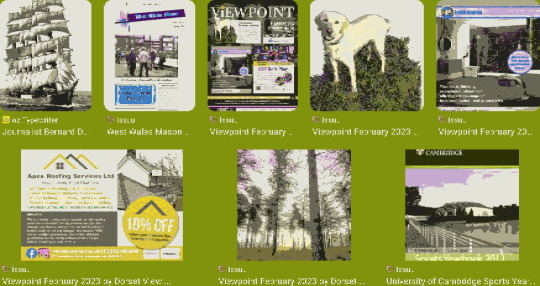
Anthony Fineran (B 1981), Chettle Dana Sail, 2023
1 note
·
View note
Text
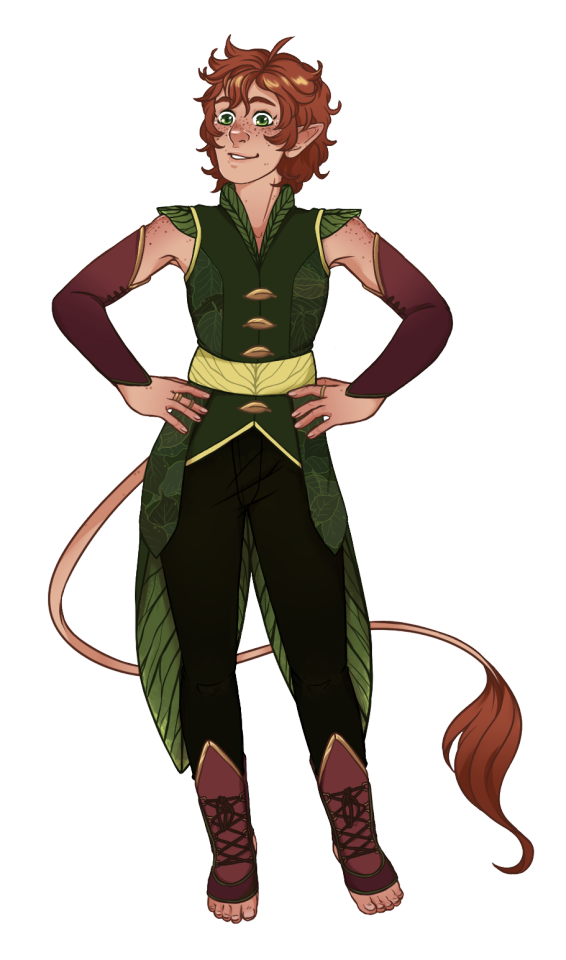
I like Robin Goodfellow an unhealthy amount and have put my own version of him in my DnD games and stories as this legendary patron who can give aid in exchange for some pretty BIG favors...
I cannot articulate how much I love Henry Chettle's (*cough cough* assuming he didn't plagiarize more folklorists and pamphleteers besides Shakesepeare...) version of this literal chaos incarnate fae who is only still known because he somehow escaped a massive book burning and folklore scrubbing in the 1600-1700s.
Robin Goodfellow, usually going by Puck, is one of the most reported fae in written record to Titania/Mab and Oberon.
That's wild, isn't it? He literally is credited with DOZENS and DOZENS of stories because we have lost the names (if ever catalogued) of the fae who those tales were originally written about...
— — —
carrd 🍄🌿 discord 🍄🌿 Twitter 🍄🌿 Twitch
— — —
🎨 me
#Robin Goodfellow#folklore#fairytales#character design#artists on tumblr#dnd#dungeons and dragons#fae#fantasy aesthetic
8 notes
·
View notes
Note
what does your blog title mean ?
in modern spelling it would be "such like raise-velvet terms," "raise-velvet" meaning pretentious, affectedly elegant. it's from Henry Chettle's "The pleasant comodie of patient Grissil":
this is one of those changeable Silk gallants, who in a verie scuruie pride, scorne al schollers, and reade no bookes but a looking glasse, and speake no language but sweet Lady, and sweet Signior and chew between their teeth terrible words, as though they would coniure, as complement and Proiects, and Fastidious, and Caprichious, and Misprizian, and the Sintheresis of the soule, and such like raise veluet tearmes.
14 notes
·
View notes
Text
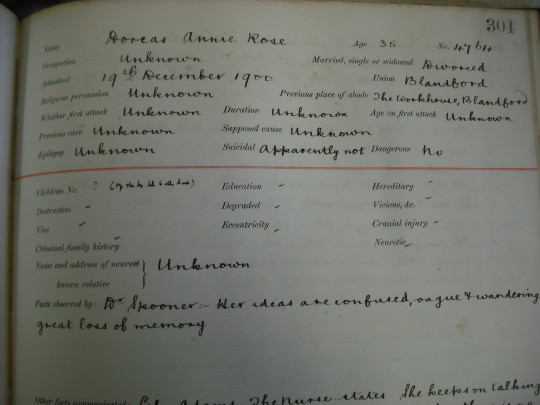
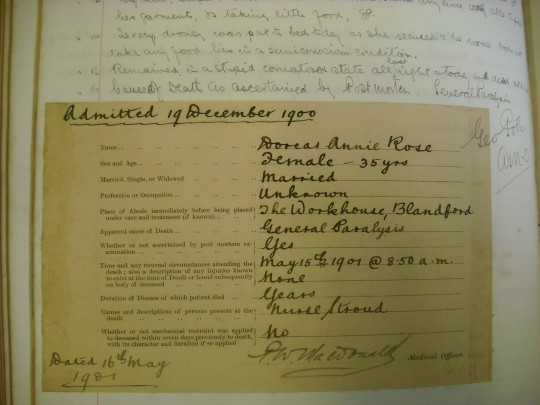
Although it’s the history of the area where I grew up that inspired my book The Diary, my love of genealogy also played a part. With family history records such a births, deaths and marriages being so readily available online, tracing ancestors has become a lot easier. Occasionally, however, a record of a different sort can give a remarkable glimpse into the lives of those that came before us, albeit in this case, a sad one.
Dorcas Annie Rideout was my great-great grandmother on my mother’s side and was born in the village of Chettle in Dorset in 1865.
She was born to Anthony Rideout and Eliza Lane and married John Rose or Roles in 1882 in Christchurch Dorset. (I had the lovely experience of visiting Chettle and was given the key to open the little church where Dorcas was baptised. The original font is still there).
Dorcas and John went on to have one child, Eliza Mabel May. This was unusual for the time to have only one child and usually meant that other pregnancies failed, or infants were stillborn. A chance discovery of a record on the National Archive website pointed to why this may have been the case for Dorcas.*
In December of 1900, Dorcas was admitted to the Herrison Hospital in Dorset. Herrison Hospital at time was a lunatic asylum. From viewing her admittance records, known as the Pauper Lunatic Reception Records, two small readable entries amongst the indecipherable physician’s script were enough to tell the sad story of Dorcas’s last years.
The admittance record has Dorcas listed as divorced. Further research shows that she was divorced in 1897, the petition brought against her by her husband. The co- respondent was named as Henry Francis who was a Hansom Cab company owner. On the 1891 census record, John Rose’s occupation is listed as cab driver. Make of that what you will.
The admittance records also show that Dorcas’ last address before being admitted to Herrison Hospital was Blandford Workhouse. This means that having no one to support her after he divorce and no means to support herself, Dorcas, and presumably her child Eliza, my great grandmother, had no choice other than the enter the workhouse. As no records exist for the Blandford workhouse, it is not known when she was first admitted but it is likely it was around the time of her divorce.
She was admitted to the asylum after she was found ‘wandering.’ The nurse’s notes in the photograph give a graphic description of the state she was in.
Dorcas was only in the asylum for 5 months before she died, her cause of death listed as General Paralysis, which in other words means Dorcas died of syphilis that she had contracted at some point in her short life. Not uncommon, syphilis was also the probable reason she only had one living child and would lead to thinking that she contracted it around the time of her daughter’s birth in 1883. Untreatable in the 1880’s, Dorcas would have lived with the disease for years until the bacteria eventually infected her brain, resulting in psychosis and ultimately her death.
Her child Eliza, 18 years old when her mother died, went on the marry a Mr Thomas Gritt, and had three children by him. But none of those were my grandmother. The father of my grandmother was another man who appeared to have lived two separate lives, but that’s another story.
*There is a something written next to the entry marked ‘children’ on Dorcas’s admittance records that is hard to make out. Possibly says ‘she says she has 6 other children dead’.
0 notes
Text
Rural Community Revive Medieval Celebration
A revived medieval event has been captured by award winning photographer Jayne Jackson in rural Dorset | Wassailing event celebrates apple trees and asks for a good harvest #Chettle #Photography #ArtsFund #Ritual
The medieval Wassailing event was captured by award-winning photographer Jayne Jackson to mark the revived tradition in Chettle, a North Dorset rural community.
The midwinter celebration is centuries-old and celebrates the apple trees in the orchards and sees the ‘Head Apple’ leads a procession to an orchard to honour the apple and wake up the spring-time.
Wassailing is an old tradition in the…

View On WordPress
0 notes
Text
Boundless game healing

#BOUNDLESS GAME HEALING SERIES#
Dr Stephanie Tierney –University of Oxford.Nick Starr – Chief Executive, The Bridge Theatre.Alistair Spalding – Chief Executive and Artistic Director, Sadler’s Wells.Dr Martin Smith – Creative Consultant and AHRC Creative Industries Advisory Group.Lucy Shaw – Head of Partnerships, Oxford Galleries, Libraries and Museums.Professor Caroline Scarles – University of Surrey.Harman Sagger - Head of Analysis, Arts Heritage and Tourism, DCMS.Laura Pye – Chief Executive, National Museums Liverpool.Lorna Probert – Producer, Aardman Animation.Rene Olivieri – National Lottery Heritage Fund Interim Chair.Karen O’Brien – Head of Humanities, University of Oxford.Caroline Norbury - Creative England, CEO.Maddy Mills – Artistic Director, Entelechy Arts.Kate Mavor – Chief Executive, English Heritage.Dr Kamal Mahtani – Co-Director of the Centre for Evidence Based Medicine.Anthony Lilley – Magic Lantern Productions.Caroline Jones – Chief Executive, The Story Museum Oxford.Victoria Hume – Director, Culture, Health and Wellbeing Alliance.Cassian Harrison – Senior Vice President of Commissioning and Global Content Services, BBC.Dominic Gray – Projects Director, Opera North.Peter Florence – Director, Hay Festival.Dr Daisy Fancourt – University College London.Nadia Fall – Artistic Director, Theatre Royal Stratford East.Sarah Ellis – Head of Digital Development, Royal Shakespeare Company.Phil Edgar-Jones – Chief Executive, Sky Arts.Michael Eakin – Chief Executive, Liverpool Philharmonic.Professor Paul Crawford –University of Nottingham.Craig Chettle – Confetti Institute of Creative Technologies, Nottingham.Nica Burns – Chief Executive, Nimax Theatres.Patrick Bradley – Managing Director, Station12.Professor James Bennett – Royal Holloway University.Hasan Bakhshi – Director, Creative Industries Policy and Evidence Centre.Dr Jo Twist, UK Interactive Entertainment.Imogen Heap, Recording Artist and Tech Founder.Professor Helen Chatterjee, University College London.John Cassy, Founder and CEO, Factory-42.Maria Balshaw CBE, Director, Tate Arts Museums and Galleries.Professor Andrew Thompson CBE, University of Oxford (Chair).Lord Mendoza, Commissioner for Cultural Recovery and Renewal (Chair).The Panel brought together expertise from across the arts, cultural, creative and higher education sectors to discuss key insights and findings and to make recommendations.
#BOUNDLESS GAME HEALING SERIES#
Recommend specific research and policy interventions to drive engagement with the issues highlighted in this report, including those which will allow the sector to maximise the potential of new digital and immersive technologies in engaging and diversifying audiences.īetween September 2020 and February 2021, the project held a series of roundtable discussions with representatives from across the cultural and creative sectors, under the guidance of an Expert Advisory Panel.
Explore the links between cultural participation and mental health and well-being and how these differ across audience and population groups.
Identify how the cultural and creative sectors can innovate through their content and business models to build resilience against future shocks.
Investigate the impact of COVID-19 on new technology-enabled distribution platforms and online cultural participation, consumption and user preferences across a range of audience groups.
Provide new data and real-time intelligence on the impact of COVID-19 across the UK’s arts, cultural and creative sectors.
The key aims of Boundless Creativity are as follows: The project has examined the role of innovation in shaping cultural experiences during the COVID-19 pandemic and generated a new evidence base to inform the recovery, renewal and future growth of the UK’s cultural and creative sectors. Boundless Creativity was set up as a joint research project by UK Research and Innovation’s Arts and Humanities Research Council (AHRC), in partnership with the Department for Digital, Culture, Media & Sport (DCMS).

0 notes
Text

Pink Owl, 2009
Acrylic on canvas board, approx. A3
Noel Chettle Memorial Art Prize, USYD.
0 notes
Text
The Journey After the Crown
Another book my friend and I pre-ordered. Historical fiction set early in Queen Elizabeth's reign so it was quite timely considering the Platinum Jubliee this past weekend!
After the untimely death of their mother, Violet and Daisie Chettle, nineteen-year-old twins, lose their father as well. They begin work as maids. Violet is good at her work while Daisie is the opposite. Despite Daisie's poor work, the women land jobs on the Queen's royal ship on a 1954 journey to Australia: the Queen's first with Prince Philip.
Violet is consumed with love for the Queen. She wants nothing more to make her journey the best it can be. Daisie, on the other hand, would rather join in mingling with the royals instead of doing her work. The sisters begin to grow apart. Especially when a secret Violet has been keeping is revealed.
This book had some good parts. The writing, though, left something to be desired. About 25 or 30 pages in, I asked myself if the author was male. Obviously yes. I don't read a lot of books by men. Not on purpose. I just must be drawn to female writers.
I rated this three stars on Goodreads. If I could, I would have rated it three and a half. It was above average but not by much.
0 notes
Text
Tuesday 22 May 1832
7 5
1 5
finish morning – F57° at 8 a.m. wind whistling as last night – afraid of rain by and by – good breakfast and very comfortable – but slept in my great coat off at 8 ¾ from Harrogate – at Ripley at 9 ¼ - very nice, neat, new-built Gothicized village – groups of cottage sin rows street-wise very pretty – fancied them at 1st some public building – a market cross – nearly opposite to it the neat small stewards’ house (now Mr. Edward? Paley at £800 a year – brother to Mrs. William Priestley) and near a neat pretty church – the hall (Sir William Inglbys’) close to the town, with castle like entrance – this vale of Nid rich and pretty - sort of Cheshire red sandstone – good land and hedges – more striking after the high common like situation of Harrogate – Ripon at 10 ¼ - took Cameron and out in 5 minutes – minster under repair – quite plain within – not an atom of painted glass – very few monuments – a little York, but transept windows lancet-arched, and towers very squat and low – walked about low Agnes gate etc. all that part of the town I used to know so well at aet. 7 and 8 – the house (where I was at school) turned into the Mechanics’ Institution – otherwise much the same as above 30 years ago – then walked towards the canal – all hereabouts that used to be open and belong to the town, enclosed by means of the late Mr. Allanson who bought and gave land in exchange for Ailsa hill and walled it off and shurbbed and planted it – to me looked better wild and open – a civil sort of woman I had picked up walked about with me – the present dean Webbe, unpopular because making a fuss about the small tithes – then called to see Mrs. Featherstone the only one now left at the house of the minster vicar Mr. Brown who used to be good to me when a child – merely introduced myself as the little girl ages ago at Mrs. Hagues’ and Mrs. Chettles’ school to whom Mrs. F- and her family used to be so good – I do not believe she made me out at all – I thanked her for all her goodness etc. and walked up and down her garden with her the whole time about ¼ hour did not mention my name cared not she should recollect the all about my father and mother and Weighton and spoke of it as between twenty and thirty years since I was there and myself being five or six of age what littleness of mind why not mention all fairly I had even some doubts whether to have called on her at all I sometimes fancy I have some magnanimity how all this undeceives me! very pretty country about Ripon – my recollections not quite so correct as I fancied tho’ yet perhaps not to be found fault with – off from the Unicorn Inn in the market place (really a handsome grande place – the column the highest and handsomest I have ever seen in any market place in England) at 11 20 for Hackfall 7 miles and thence to Masham 5 (the direct road would be to Leeming lane 10 miles and thence to Catterick bridge 13) – the Hambledor hills fine in the distance (right) – picturesque grit-stone village of Gruelthorpe [Grewelthorpe] at 12 25 famous for its cream cheeses from 6d. to 2/6 – turn down a little steep hill and in a minute or 2 at Hackfall house i.e. the cottage opposite the gate into the grounds – just 1 ½ hour making the tour till 1 55 – a beautiful winding richly oak-wooded valley with the river Eure that rises in Wensleydale which dale begins as it were at Leyburn taking in Middleham etc. a pretty shallow stream [?] along the narrow bottom – huts, and seats, and [?], and a mock old ruined Mowbray castle well enough placed on the different points of view – from Mowbray point on which a sort of banqueting room with little kitchen adjoined – fine extensive view – just below the extreme point this way of the Hambleton hills appears like a little squat blue cone Roseberry-topping, near Stokesley a little deeper misty blue than the clouds, distinguished York minster, 30 miles off – village of Tanfield – (hall not visible) – Sleningford hall (Staveley – married daughter of Claridge of Jervaux, and brother to Staveley of Tanfield hall belonging to Lord Aylesbury) and new Sleningfield hall colonel Dalton – this beautiful village of Hackfall consist of 80 or 90 acres all wood – this and a few farms all Mrs. Lawrence has here – 6 miles from Studgley – Hackfall bought of a poor man by Mr. Aisleby Mrs. L-s’ grandfather about 100 years ago – Mr. Danby Lord of the manor here – the land chiefly belongs to little freeholders – lets at 30/. an acre – the best, and not of the best quality about here – sells for £100 an acre – some let for convenience at £5 an acre – higher on account selling the cream well for cream cheeses – very fine day – at Masham at 2 ½ Kings’ head Inn the only posting house – irregular, little, goodish, calcareous grit-stone, market town with good, neat, spired church and very large square market place with small market cross in the middle. Said I had only paid 15 pence a mile at Ripon, and .:. got off the additional penny here – Middleham 10 miles from Masham town-end and Leyburn 12 miles – at Jervaux abbey at 3 40 – a confused plan of ruin covering a very extensive space – part of the plan only traced out in 1814 by the present Lord Aylesbury who was drown 4 years ago – no house for him but the one his steward Mr. Claridge lives in – a neat, plain small common gentleman’s house with nice gardens and grounds – the Refectory with ½ dozen lancet arched windows 2nd story the most conspicuous part of the ruin – Yoreval abbey (from Eurc val) valley of the Eure) founded in 1141 destroyed in 1537 – 25 minutes in the grounds and off again at 4 5 – return about a mile the same road we came then turn off to the village of Newton-le-Wilton and Attrick to Catterick bridge 13 miles – plenty of stone fences just about Jervaux (pronounced Jār-vă) – Attrick nice village about 5 miles from Catterick bridge and 1 beyond Newton le Wilton, with nice very good church – nice farming country – at 5 25, 3 miles from Catterwick see Hornby castle in the distance left – a good plain looking house from this 1st point of view – then at 5 35 pass very neat, low, battlemented, Greek-cross (centre part higher than the 4 limbs) lodge – (too many young, single trees in the grounds hereabouts – many long pieces of old thorn hedges left standing with about as much interval as hedge, and this answers better in point of look than might have been imagined) – and the house looks more deserving its name of castle – at Catterick at 6 a village-like little town with neat small church – a mile beyond is Catterick bridge a good stone bridge over the broad shallow Swale – the Inn a large good-looking stuccoed house – just opposite on the other side the road is the race ground – just over the bridge a few goodish cottages and a little ale house – except from Harrogate to Ripon and to within about 4 miles of Catterick, cross roads, really very fair ones, all today – no reading at all today – made the pencil notes of today and amused myself with musing – first of Lady Gordon incline to her thinking as I often do in travelling of Shiden and alterations there – planting – making a road traversing along Baristow to Southowram – a toll of 2d. per cart and ½ or 1d. per horse would pay? – if the speculation would pay 10 p.c. it would do – nice enough little village of Scorton at 6 ½ - no trace of a gentlemans’ house – of Mr. Bowers where my aunts used to spend so much time when young – at 7 ½ first peep at Croft bridge – how well it looks – stretching across the board Tees and the very valley itself? at the Rectory at 7 40 – all out for the moment but Mrs. James Dalton and IN-
SH:7/ML/E/15/0072
a nice enough welcome – a little dinner tray brought in – minced veal, ham, etc. – then tea – came to my room at 10 50 – IN- came up with me and sat with me till 11 50 at which hour F61° in my bedroom (no fire) – very fine day after 12 – and very fine evening - Marianne Dalton queer and violent and disagreeable as ever -
1 note
·
View note
Text


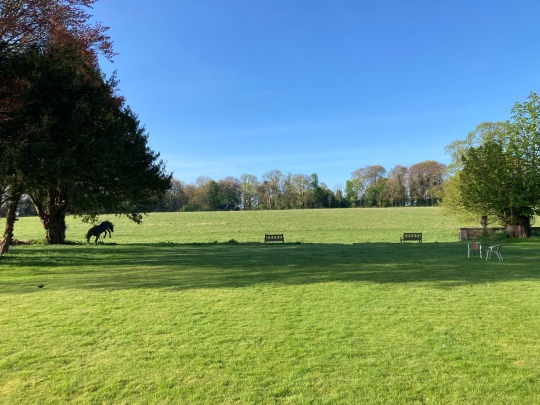


Im Castleman Hotel in Chettle, Dorset treffen wir auf die Sachers und eine viktorianische Inneneinrichtung.
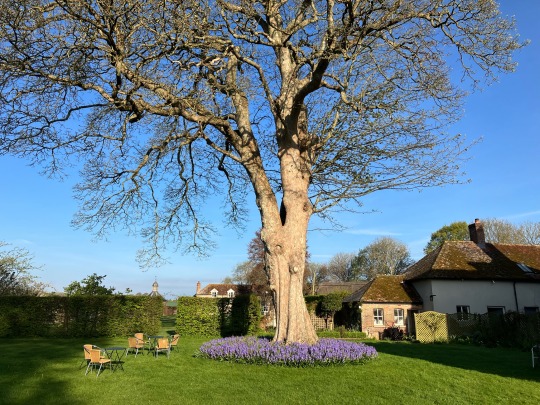
Platanenbaum (Sycamore tree) mit blauen Glockenblumen (Blue bells)
0 notes
Photo

Chettle House, Chettle, North Dorset, United Kigdom,
Photograph: Paul Highnam/Country Life Picture Library
#art#design#interiors#interiordesign#chettle house#manor#staircase#grand staircase#queen anne style#dorset#united kingdom#chettle#thomas archer#luxury houses#luxury homes#luxurylifestyle#countryhouse#style#history#paul highnam#countrylife
803 notes
·
View notes
Photo

Have have the new @the_chemex #chettle I stock along with lots of other Chemex products ready to ship for #holidaygifts ! (at Brewtus Roasting) https://www.instagram.com/p/B5TEFUxhUwq/?igshid=82sf67snj0d3
3 notes
·
View notes
Text

From our stacks: Cover detail from Bonnie Bairns. Verses by E. M. Chettle etc. Illustrated by Helen Jackson. Edited by Edric Vredenburg. London, Paris, New York: Raphael Tuck & Sons, n.d.
#helen jackson#bonnie bairns#books#book covers#cats#library books#childrens books#old children's books#old books#book#book cover#cat#catbot#bubble buns#e.m. chettle#children's books#children's literature#children's illustration#illustration#vintage books#vintage illustration
38 notes
·
View notes
Link
“The publishing revolution of the sixteenth and seventeenth centuries witnessed an explosion of printed material, democratising information and pushing it into the hands and sight of more people than ever before. A large single sheet of cheap paper could be printed with a proclamation, adorned with a woodcut, and sent out among the masses. These broadsides were sold for a penny on street corners, pasted on ale-house walls, and stuck up on market posts. In 1592, the playwright and stationer Henry Chettle described how ballads “infected London the eie of England”, then travelled through the country via ballad-mongers, who could “spred more pamphlets by the State forbidden than all the Booksellers in London”.1 There was a hunger (then as now) for tales of sex and scandal and, for the first time, a network of illustrators, printers, and distributors were able to glut this desire. The Jacobean playwright Thomas Middleton referred to ballads as “fashions, fictions, felonies, fooleries”.2 Cheap print was the medium of the masses, and the crude woodcuts were the visual language of Early Modern England.
This revolution in publishing coincided with what has been termed “the European witch-craze”: a moral panic and collective psychosis that spread through Europe and Scandinavia during the sixteenth and seventeenth centuries. The seed of this hysteria was planted in 1484 when two Dominican Inquisitors appealed to Pope Innocent VIII for permission to launch a witch hunt, and he responded by issuing a papal bull authorizing their efforts. Two years later they published their treatise, the Malleus Maleficarum (“Hammer of the Witches”), which, for the first time, elevated witchcraft to the crime of heresy and justified its extermination with papal authority. Leaning heavily on the supposed papal endorsement, the Malleus Maleficarum painted a terrifying picture of witchcraft and preached the absolute necessity of vanquishing this largely unrecognised evil.”
.....
“ The folkloric image of the crone was established through these images and repeated in similar pamphlets over the next century. These witches were usually bitter old women, who lived on their own, and kept cats or other animals as pets. The Wonderful Discoverie of the Witchcrafts of Margaret and Phillip Flower, Daughters of Joan Flower neere Beuer Castle (1619) and A Most Certain, Strange and True Discovery of a Witch (1643) are particularly famous examples that reinforced this archetype. Latent sexism and fear of those who lived on the fringe of society doubtless motivated much of this persecution.”
#witches#witchcraft#malleus maleficarum#thomas middleton#henry chettle#jon crabb#public domain review#witch hunts#moral panic#woodcuts#sexism#patriarchy#matthew hopkins
32 notes
·
View notes
Text
A while ago I was looking through the Directory of London for the year 1794 to see what women were listed as running businesses that year, and I wanted to put the ones I found here in case anyone else finds the list interesting:
Elizabeth Andrews, goldsmith and jeweller
Rose Beckford, merchant
Susanna Bower, orange merchant
Mary Burt, ironmonger
Alice Butler, hatmaker
Eliz. Carson & Co, Letter Founders
Ann Centlivres, merchant
Sarah Chettle, oil and color shop
Penelope Clarke, fan maker
Mary Clement, China and Glass Seller
Eliza Cock, biscuit baker
Ann Cope, silk mercer
Susanna Curteis, brewer
Mary Deacon, manchester warehouse
Ann Ducroz, Flower & Ostrich Feather Manufacturer
Sarah Evans, Silk Dyer
Eliz. & T. Gillepsey, coal factors and sail makers
Elizabeth Harlow, Bookseller
Mary Harris, silk throwster
Sarah Hill, Oil & Hop Merchant
Mary, Thomas, and John Jackson, Coal Merchants
Elizabeth Jagelman, biscuit baker
Sarah James, Cooper
Ann Jones, plumber
Phoebe Kemerer, Tanner
Hannah Leaverston, Ship & House Brazier
Charlotte Matthews, Merchant
Jane Mayor, brass founder
Elizabeth Mock, carpet warehouse
Mary Napper, Dyer and Calico Printer
Elizabeth Newball & Co, Coach-Founders
Elizabeth Newberry, Bookseller and Stationer
Mary Noble, rag merchant
Beliza Oldham, Button-seller
Ann Oram, Plumber and Glass-cutter
Jane Robertson, Turner & Toy Dealer
Mary Shirley, Cooper
Hannah & Thomas Sibley, Haberdashers and Glovers
Mary Smith, carpet warehouse
Elizabeth Swain, Upholsterer
Ann Thwaites, Brandy and Rum Merchant
Mary Wilkinson, Block-Maker
Some notes:
- That’s a lot of different occupations represented! Sure, we have some things that we might consider stereotypically feminine work - fan makers, button-sellers, and hatmakers - but we have even more women working in occupations where we might not expect to find them - coopers, smiths, plumbers, and tanners.
- A few of these women probably apprenticed into their trades, but I’m betting that most of them are widows. And that’s important, because every occupation that we see women taking over from their husbands when widowed is an occupation that the widow must have participated in, to some extent, when her husband was alive, or she wouldn’t have the skills necessary to take over the shop when he died. That means that we can expect that lots of other businesses on this list were also making use of female labor - a business owner’s wife is only very rarely listed as a co-owner, but that doesn’t mean that she might not be doing the same sort of work that he is.
- Romance novels set during this time period tend to be about the upper classes, where women were expected not to work (which, to be clear, left them with about three fewer employment options than men of the same social class), and where marriage was therefore very important. But I have to figure that who you married was also pretty important for middle-class women - after all, it looks like who you married might well decide what sort of work you were doing for the rest of your life!
- No, I don’t have any idea what an “Ostrich Feather Manufacturer” is.
- It should be noted that this is a list of a few dozen female tradespeople out of a list of thousands of men (although there are probably a few other women on the list that we can’t be sure of, since some people go only by initials or last names). The vast majority of people who ran their own businesses were still men; I am not claiming that the 1700s were an egalitarian era, or that all of the options open to men were also open to women. But I think this still tells us something about what middle-class women were doing in this time and place, and the answer is that they were doing a LOT of things.
56 notes
·
View notes
